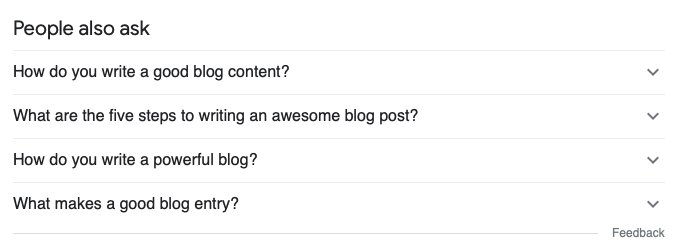The benefits of an excellent blog post are twofold. First and foremost, they serve to inform readers and position the brand as a thought leader in its space. This makes them great for sending over to prospective clients or customers, and helps build credibility with website visitors. Second, blogs can have high Search Engine Optimization (SEO) value to the website by getting it indexed higher and with more relevant content.
Here are some tips for small businesses to write blog posts that actually drive traffic and sales:
1. Take Time to Research
Blogs are just as much about enabling people to find your content as they are about giving your readers value. That’s why we can’t understate the importance of doing keyword research and choosing the right phrasing for search engine optimization. Speaking directly to what your target customers are looking for is one of the most effective ways a small business can make an SEO impact.
To get started, think about the questions your customers frequently ask you. In the case of this article, we often get asked how to write an SEO blog for small business use, so we figured it would be a great topic to cover about! Once you’ve got a good idea of some various blog topics, try putting them into Google to see what pops up. There’s even a “People ask” section on Google search that can help you find the ways people typically phrase certain questions.
See below screenshot from the Google search results – these are other related questions we might also want to write about! If questions show up here, they likely have significant search volume.

Finally, we recommend using a tool like Google Keyword Planner to help give you an idea of the search volume certain keywords have, and what other keywords can be used concurrently with your blog topic.
If you are a small business with a modest SEO presence, try to choose narrow topics with lower competition levels, and keep a tight theme around all posts surrounding this topic. Write about things that are hyper-specific to your exact niche audience for a better chance of ranking in search results. For example, rather than writing about “How to write a great blog”, we are writing about how to write a blog for SEO for small businesses – a much less competitive topic!
2. Pick the Right Title
Your blog has a split second to capture the attention of a potential reader. The title is both the first impression and the hook. Whether it be search engine traffic or social media traffic, both audiences will look to the title to decide whether or not to make the decision to open your content.
So how do you get the most out of your blog’s title? Readers love content that is engaging. Whether it’s a listicle or an answer to a question, make sure you’re providing value from the get-go. For example, this article is a how-to guide on how to write a great blog to drive traffic as a small business, and that is reflected simply and succinctly in our title. This way, if someone searches a similarly-worded question on Google, our blog will also be more likely to pop up among the results.
When writing your next great blog, tell readers exactly what they can expect from your article, without giving away too much. Just a little taste of why they should be going to your website instead of continuing to scroll.
Pack it with your focus keyword for extra SEO, and you’re well on your way! A few great title examples we’ve written for clients include:
- “Top 10 Girls’ Birthday Party Venues in Headland, Alabama” that we wrote for Pinspiration, a DIY arts and crafts studio with a location nearby keyword-specific
- “Thermal Runaway Effects in Batteries” for Odyssey Power, a B2B company that specializes in backup power and batteries for industrial use
3. Well-Organized, Comprehensive Content
Another rule of thumb for blog writing is to keep your content thorough and well-organized. Consider that the majority of your readers will be initially introduced to your article while on their phone or scrolling. For anyone that decides to click onto your blog, the content of your article and its readability will quickly help them decide if they should continue reading or exit out.
Don’t be afraid to write longer articles. Readability doesn’t mean cutting down your content, it just means formatting it in a way that’s visually pleasing on both mobile and desktop. When writing an SEO blog for your small business, shorter does not equate to better – instead, focus on writing actually helpful articles that may create repeat visitors as a result.
Use these to make content easy to navigate:
- Subheadings
- Bulleted sections
- Graphics
- Visual cues (colors, highlighting, bold)
- Short paragraphs (3-4 sentences for most paragraphs)
4. Meta Description, Alt Text & More
Another way to drastically improve the effectiveness of your blogs is to fill out all of the text opportunities that are present on your article. This includes places that don’t immediately appear to website readers, but are obvious to search engines going through your site. The following aspects are important for SEO:
1. Heading tags (read more here)
Your headings are actually classified by search engines under a hierarchy. The next time you write an SEO blog for your small business, take a look at the formatting options you have available. There are tags that can delineate certain headings from other ones, signalling to Google what your most important content is. For example, each of our steps to writing a great SEO blog are marked as “H2” headings, which gives them a higher priority to other text within this article.
2. Meta Title and Description (read more here)
When it comes to meta description, this is the text that appears when your website is shown in a search. It appears just below the title text, and gives readers an idea of some of the high-level topics that are included on a site. Think of it like preview text to help hook more people into reading your blog. If left unedited, your meta descriptions will generally default to the first text that appears on your article.
3. Alt Tags for Images (read more here)
If you have a photo in your article, be sure to write a brief description of what is happening in the image, and give it a name/alt text that includes your focus keyword or branding. The next time a search engine scans your article, it will index the images you used as another way for people to find your blog.
5. Internal Links
One of the main goals for any professional blog is to increase time on page and page views, as both of these contribute to how high google will rank your articles. Make the most out of your blog traffic by giving readers another place to go for more helpful information. If they’ve been reading your work long enough to get to a link to another page, chances are they may go ahead and click on it.
If they do click it, it’s extra points for your SEO, since you just converted a visitor into someone who’s taken multiple actions on your site. Since pages like Google take into account what readers do once they get to your article, their algorithm will make note of the fact that people are finding your information relevant enough to continue reading other articles as well.
Internal links also act as extra strands to the web that connects your website. Consider each link as a pathway to another part of your site which gives Google an idea of the structure of your website so that it can establish a hierarchy of important pages. This in turn helps search engines serve your content more effectively.
>> Related Article: How To Make Marketing Easy And Fast (Really!)
External links are also important (linking to other relevant websites where users can get more information) but internal links have the additional value of keeping users within your own content.
6. Finish With a Call To Action
And finally, finish your blog off with an effective call to action. Something that may get readers to engage with even more of your content. Remember, our ideal situation would be for them to stay on the site for as long as possible, clicking through multiple pages. A call to action helps ensure that the current interaction isn’t going to be the last one your audience has with your brand.
As a digital marketing agency, we like to place our CTAs in the footer of our articles as well as wherever it is relevant throughout the blog post.
Another great way to create a bold, noticeable CTA is to build a button into the bottom of your blog. Something that aesthetically stands out enough to draw a reader’s attention with text saying “Click here to learn more” or “Shop Now.” You want to be using action verbs for your CTA to more effectively mobilize your audience. These also work great on landing pages, learn more about those by clicking this subtle CTA here.
Need Help with Your Blog?
Writing a great blog doesn’t have to be an uphill battle. If you feel like your business needs help better managing (or creating) digital marketing campaigns, let us know and we would be happy to talk about your digital marketing strategy.


